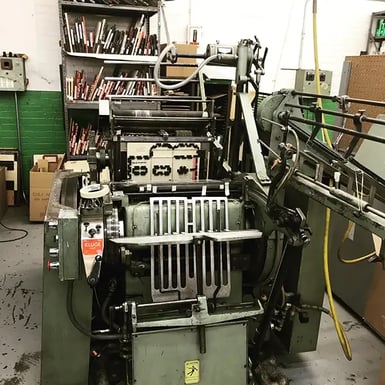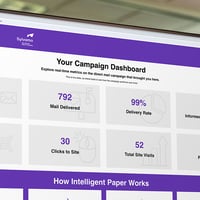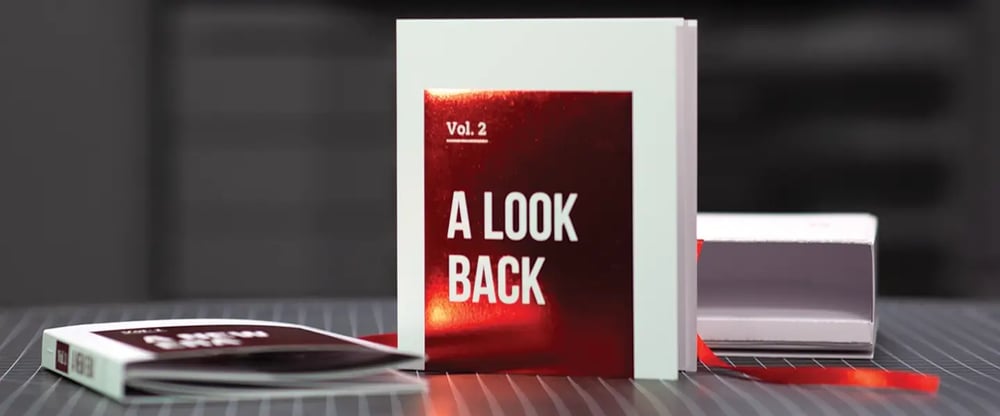Accent On: Artist and Educator BO Haynes
Did you catch our recent project profile on this handcrafted LED-lit slip-cased book set? (If not, click through because this illuminating piece is worth a look!)
This interactive print project was the creation of BO Haynes. BO is many things: an artist and educator but also a storyteller, a technologist and a self-professed geek. He was kind enough to chat with us about his career path, favorite projects and where he looks for inspiration.
What’s your origin story — how did you get started in your creative career?
I come from a creative family who encouraged coloring outside the lines. My mom retired from 50 years in advertising and my dad has spent nearly 60 years in furniture design and woodworking. My older brother has been an independent designer and storyteller in the comic book industry for the past 30 years.
I was fortunate to take part in a comprehensive four-year high school program for advertising and graphic design. It was one of the only programs of its kind in the country and was led by an incredible creative named Rick Lacek who switched careers to become an award-winning educator. The mid-90s was an exciting and transitional time to learn design because we were getting experience with both the emerging digital methods and the old-school methods. For example, we learned to proficiently mask images in Photoshop and by hand using Rubylith. Rick’s passion for helping us understand and appreciate how things worked left a lifelong impact on me. Perhaps it’s no wonder I’ve spent the past 20+ years as a creative.
With that said, I followed a somewhat unusual path. I wound up entering college as a music performance major before switching freshman year to economics (yes, seriously). I later went on to earn an MBA and have recently started a second master’s in leadership and strategy. It’s safe to say I’m not the typical creative director. My happy place is being able to tell stories that combine creative, technical, and analytical perspectives.
Today I am the deputy director of a full-service 40-member creative studio, which I joined as a freelance designer in 2003 for what was supposed to be a three-hour project. One project led to another and I joined full-time later that year. I’ve seen our team and the creative industry grow and change so much in two decades. Our studio now provides graphic design, 3D, illustration, video, interactive, writing, branding and of course print. I lead our copywriting team, co-lead our graphic design team, and lead our Creative Production team, which focuses on all types of physical deliverables from print to fabrication.
One of the early highlights of my career was the opportunity to partner with the Charlotte Chamber and local school system, volunteering to teach graphic design and introductory 3D modeling as part of a technical afterschool program. This included my teaching for a couple of years in Rick’s classroom with him as the faculty sponsor, which was a particularly meaningful milestone for me.
Tell us about your relationship to paper. What role does it play in your practice?
To me, paper is kind of everything. I am a paper-first creative. I love how interactive it can be from texture to form and function. I have shelves lined with paper sample books. I sketch as part of my daily work and start that process on paper most of the time. That’s how I think and explore.
I look for ways to make the paper itself a leading character in my art and ideas. This can lead to simply celebrating whitespace or a complex dieline. Along those lines, I really love movable books, which include pop-up and other paper mechanics. I’m even a card-carrying member of the Movable Book Society.

One of my all-time favorite projects was my first to require a Kluge, as it had custom dies made for both cutting and hot foil stamping.
It also included my first professional pop-up element. This along with a minimalist design allowed the paper to be front and center, though the engineering itself was complex including custom LED circuits I hand built individually.
.png?width=1000&height=372&name=TPT-PAH-Jacket%20(1).png)
Another freelance highlight involved many moving pieces related to production and paper. I collaborated with The Perfect Thing founder Barbara Ivey who is a source of information for Alzheimer's caregivers. I partnered with her on everything from branding, packaging and tradeshow materials to illustrating and designing her primary resources: a hardback book with dust jacket and wide-format gate-fold reference booklet.
Like many creatives, I look to push myself artistically during the month of October. I started early on with ink and illustration. One October, every illustration was driven by my selecting a notebook with black paper.
In more recent years, my challenge of choice has been #PopUpTober, and I’ve been pretty happy with some of those concepts over the past few years.
Notably, a carryover from the freelance project mentioned above is that I have a lifetime supply of LED lights and coin batteries, so I keep gravitating to new ways to incorporate battery-powered lighting elements into my paper projects.




I often incorporate humor into my art. A paper-based design series I have had a lot of fun with features color-related puns (or “on-color jokes” if you will) that star a shape-shifting color swatch and its sidekick, a red line.
In addition to paper, what are the other tools that are crucial to your personal craft?
While I enjoy playing around with new media, art supplies and tools as much as anyone, I believe I’ve settled in the past few years on my bare necessities:
- Legal-sized paper, or as I call it “widescreen paper”
- Lead-holder-style drafting pencils
- Pentel Hi-Polymer erasers
- Black Uni Pin Fine Liner Pens in 005, 02 and 05
- Light Cool Gray Sakura Koi Coloring Brush Pens
- Sakura Koi Travel Watercolor Set with water-filled brush
- X-Acto or Excel Blades in a holder with a working safety cap
- A metal ruler that does not have unmarked space at the ends outside of the measurements
- Basic bone folder
- A variety of quality single-sided and double-sided tape
- Music playing on over-ear, open-back headphones (usually my trusty Massdrop X Sennheiser HD6xx)
Sometimes my final art can be created with these tools alone, but at a minimum they can be used to effectively capture just about any idea I have.
Who or what do you look to for inspiration?
I could write 20 pages on how easily I geek out. I find so many things inspiring. My home bases for inspiration are the library, which we visit as a family nearly every weekend, and Instagram. My IG feed has creators and artists covering seemingly every medium. I kicked off the year with a non-paper-related highlight when LEGO’s official IG account commented that they liked a dragon I made by combining the pieces from two retail sets for a Vespa and Amelia Earhart.
I am more inspired by seeing the process than just seeing the finished product. I appreciate final art but learn so much from artists who share their sketches and insights. Sharing works in progress seems to be something creatives are increasingly willing to do, and I am here for it!
Lastly, I’d be remiss if I did not take the opportunity to give a nod to the artist who has been hands down my favorite for going on 30 years: the mixed media artist Sally Rogers. Her work is at the top of my list for daydream lottery winnings. As a bonus, an artist who I learned about in the past several years who has similar artistic qualities is Chuck Fisher.
What advice would you give to emerging graphic designers?
I am a longtime hiring manager, mentor, former college educator, college advisory board member and active member of the American Advertising Federation’s collegiate programs. Those experiences have allowed me to answer this with a few tried and true bits of guidance picked up over the years:
- Find a mentor and become a mentor. Driven, enthusiastic talent never falls out of fashion. Join industry organizations and share your interest in establishing a mentor relationship. You’re never too early in your career to be a mentor and never too far along to be mentored. AIGA is particularly well known for their mentorship program, but any industry should have avenues to make those connections.
- For your portfolio, show the kind of work you want to do. To put it another way, don’t include anything in your portfolio you don’t want to be hired to do again. I see this as sort of a loophole for our industry compared to other industries: you can show concepts and passion projects in your portfolio. Just be super clear about what is client work versus conceptual work.
- If you’re a designer and your resume is designed, be aware that you’ll be reviewed on the design and content. In my specific scenario, probably only 20% of the hundreds of resumes I see every year are designed. So, unless typography and page layout are your strong suits, I’d make sure it’s an expectation that the resume will be designed.
- Relatedly, if you’re a visual creative, have your resume, portfolio, and site reviewed by one of your copywriter friends. There is no rule that you have to do elements yourself that you are not providing as a service. Meaning if you’re not selling copywriting services, feel free to get someone to help you with the copywriting to make your content stand out.
- Gain comfort selling your ideas. If you’re not comfortable presenting, find supportive opportunities to practice. A lot of our role as creatives is helping non-creatives understand and advocate for our ideas.
Thanks so much to BO Haynes for taking the time to chat with us! Follow BO on Instagram to see more of his work.






